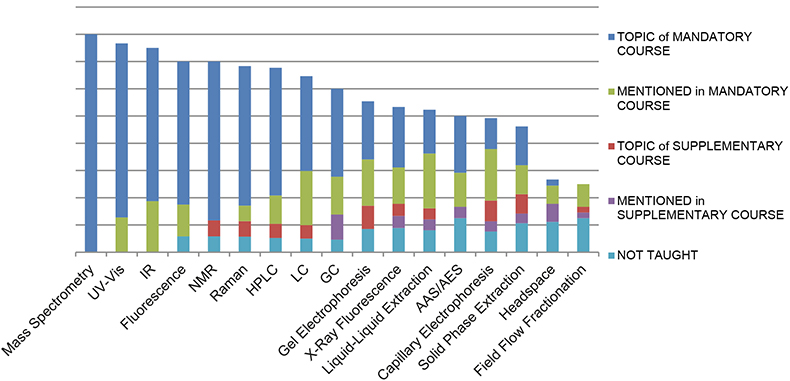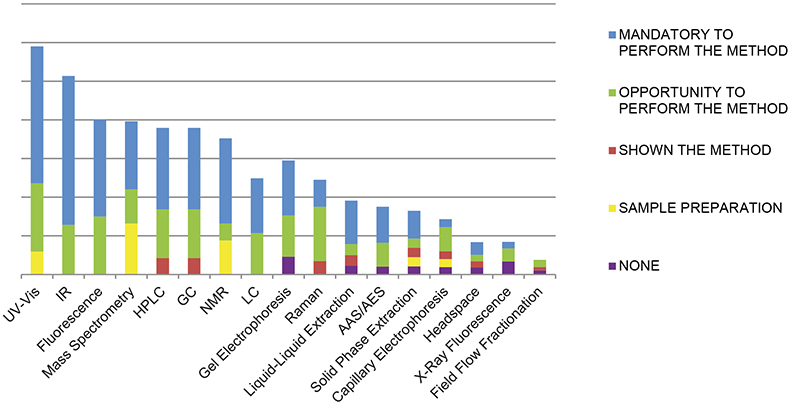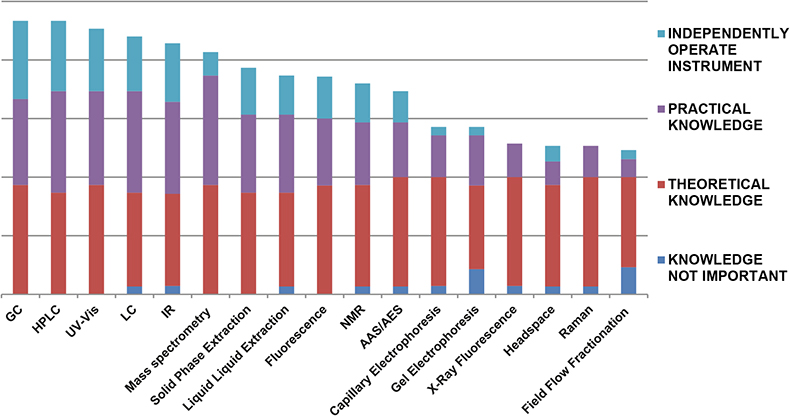Jennipher R.J. Dania,a Joachim Isaak Zahradnika and Antony N. Daviesb,c
aVan ‘t Hoff Institute for Molecular Sciences, University of Amsterdam, Postbus 94157, 1090 GD Amsterdam, the Netherlands
bExpert Capability Group – Measurement and Analytical Science, Akzo Nobel Chemicals b.V., Deventer, the Netherlands
cSERC, Sustainable Environment Research Centre, Faculty of Computing, Engineering and Science, University of South Wales, UK
In this column we would like to explore the initial results extracted from the survey into the training the next generation of colleagues currently receives in analytical chemistry. The background and some details around the survey were provided in the previous column and will not be repeated here.1
First, a great vote of thanks from all three of us to those who have so far participated in the survey. Roughly equal numbers have completed the academics’ and industrialists’ surveys. This gives us the ability to let you know that the average time taken to complete the industrialists’ survey was just over nine minutes and the academics’ survey just over four minutes so if you have not does so yet—it is not too late as the links remain open… please go to the survey links below.
Assessing the academic responses—taught courses
As I started to look at the results I realised that some decisions would have to be made on how to weight and visualise the answers we were receiving. As the survey has been crafted to harvest as much information as possible whilst consuming as little of your precious time as possible, it does not dig deeply into the content of what is actually being taught or requested. At the extremes of the response scales there are obviously no problems—a subject being the topic of a compulsory course is clearly ranked the highest and a topic not being taught at all the lowest. However, how do you value the perceived importance being given to a topic which is covered only in a supplementary course which a student may well opt not to take, as opposed the same topic being mentioned—but not the main topic—in a mandatory course all students need to attend.
Interestingly, this mirrors, to a certain extent, the discussions around the types of analysts we are looking to recruit in the future. I am personally very much in the camp of looking for “T-shaped analysts”. Stolen from the business concept of T-shaped managers, this has nothing to do with recruiting colleagues based on the hours per-day they spend in the gym. I like to look for people who can not only contribute to our teams by bringing new deeper insights on a specific field, but have the experience and personality to be able to contribute across teams and expertise areas sharing lessons learnt. In the past, I have often seen cases where a spectroscopist will continue to struggle with a complex problem using the tools at their disposal, sometimes for months, just because they were asked a specific question but did not have the experience or network to know that a different group even just down the corridor could actually solve the problem in a fraction of the time. So where does that leave us? I have concluded for this column, maybe a little controversially, that being exposed during your academic training to the strengths and weaknesses of many different analytical techniques will probably be of greater value later in your industrial career than spending too much time going deeper into only a few techniques. Sorry if you disagree!
So, if we look at Figure 1 you can see how I have assessed the responses to the first question for academics on the coverage of analytical techniques likely to be encountered in industry.
These results were somewhat surprising in that I would have assumed the main chromatography techniques would have been at the heart of all analytical chemistry teaching. The lack of priority given to some of the key sample preparation techniques which must be mastered as a matter of course, since spectroscopists are constantly driven to deliver lower and lower limits of detection, is worrying.
Focussing on the spectroscopic techniques, the results are probably a little less surprising for me with the exception of the weakness in the teaching of atomic absorption and emission spectroscopies.
Assessing the academic responses—practical courses
Here again, I have imposed an arbitrary weighting on the responses for the visual representation of the importance of the topic shown in Figure 2. I have given particular weight to the techniques which are mandatory for a student to carry out in the laboratory during their education. I have applied somewhat less weight if this hands-on experience is not mandatory. Much less weight has been given if they only carry out the sample preparation steps and hand the sample over to be measured for them, or if they only have the method demonstrated to them and do not actually get to touch the equipment themselves.
As mentioned in the first column on this survey, we may now actually see the cost of running academic laboratories coming in as a bad, if unavoidable, influencing factor in the selection of topics being taught to students in the laboratory.

Figure 1. Weight given to teaching different analytical techniques.

Figure 2. Weight given to laboratory-based training in the different analytical technqiues.

Figure 3. Weight given by industrialists to knowledge in the different analytical technqiues.
Do the industrialists agree?
Well, if we look at Figure 3—unfortunately in many areas they do not. I have not tried to weight these responses as I found I was effectively looking for answers which agreed with my prejudices! I have let the numbers speak for themselves. For me the biggest revelation is the strong preference for employers in a broad theoretical knowledge across pretty much all the techniques mentioned in the survey. This goes against what we see from the academics, where students may well not have been taught many of the subjects important in the industrial labs by the time they finish university.
Industrialists also clearly believe that a much greater level of practical skills is to be expected from students they are recruiting than is reflected both in the breadth and in the depth of what they receive at university.
As to the other skills being taught to future industrial analytical chemists, the prioritisation of the most wanted skills is not too different from the ranking placed by the educationalists (Table 1).
However, there was a very interesting comment made by one of the industrialists’ survey responses around the balance of priorities between “soft skills” and hard technical ones. An area the structure of the survey didn’t address…
“…There could be more focus on other skills such as communication (all kinds), influencing, idea generation, but also executing ideas etc... skills next to “analytical thinking”. In general, we looking into these skills rather than knowing how an LC works.”
Some respondents did also complain that the courses seemed to deliver too much “soft-skill” training as opposed to the analytical skills. Another interesting point in exactly this area, but also one not addressed in the survey, was around the underlying assumption that we were trying to match graduate skills against their future employment environment. However, one respondent pointed out…
“University graduates do not usually get a position at the lab bench in my company, but are working as project managers. The softer skills such as project and time management, communication etc. do not seem to get a lot of attention in their academic training. Also, the analytical chemistry knowledge usually does not completely match with what is important in our industry and a lot has to be learned on the job. Problem solving skills and analytical thinking are usually well developed.”
Table 1. Prioritisation of other skills between educators and employers.
Other skills prioritisation | |
Academic | Industrial |
Problem solving and critical thinking | Critical thinking and problem solving |
Literary research | Ability to work in a team |
Communication skills | Communication skills |
Sample handling | Ability to work independently |
Design of experiment | Time management |
Sampling | Ability to perform efficient literature searches and information retrieval |
Laboratory management | Knowledge of statistical procedures |
Project management | Project management |
High throughput screening | Design of experiment |
Table 2
| Prioritisation | ||
Rank | Industrial | Academic teaching | Academic laboratories |
1 | GC | Mass spectrometry | UV-Vis |
2 | HPLC | UV-Vis | IR |
3 | UV-Vis | IR | Fluorescence |
4 | LC | Fluorescence | Mass spectrometry |
5 | IR | NMR | HPLC |
6 | Mass spectrometry | Raman | GC |
7 | Solid phase extraction | HPLC | NMR |
8 | Liquid–liquid extraction | LC | LC |
9 | Fluorescence | GC | Gel electrophoresis |
10 | NMR | Gel electrophoresis | Raman |
11 | AAS/AES | X-ray fluorescence | Liquid–liquid extraction |
12 | Capillary electrophoresis | Liquid–liquid extraction | AAS/AES |
13 | Gel electrophoresis | AAS/AES | Solid phase extraction |
14 | X-ray fluorescence | Capillary electrophoresis | Capillary electrophoresis |
15 | Headspace | Solid phase extraction | Headspace |
16 | Raman | Headspace | X-ray fluorescence |
17 | Field flow fractionation | Field flow fractionation | Field flow fractionation |
Summary
Table 2 shows a summary of the weighted assessment of the different priorities given to different topics by industrialists, academics planning lecture courses and academic practical laboratory work.
As I feared there does seem to be a need to re-align priorities. More emphasis on the preparation techniques for handling samples in the academic arena is needed to ensure that graduates of the future are better suited to the world in which they will need to find employment. As to the availability of more expensive spectroscopic techniques, I think there could also be lessons to be learnt around industrialists understanding the financial pressures that universities find themselves under. They might decide to take concrete steps to help ensure access for students to facilities their universities can no longer justify maintaining on cost grounds. Additionally, the weighting between hard analytical skills and the softer work-place integration type of skills seems to be of concern.
Finally, if you have not yet completed the survey please find some time today to do so. As mentioned in the title, this is just a quick preliminary look at the results that have come in to-date and a much stronger statistical base from respondents from a wider geographical area would be greatly appreciated!
The surveys
To access the Academics’ Survey please use this link:
To access the Industrialists’ Survey please use this link
www.surveymonkey.com/r/MYSKVMG
Reference
- J.R.J. Dania, J.I. Zahradnik and A.N. Davies, “Training future analysts”, Spectrosc. Europe 30(2), 20–22 (2018). http://bit.ly/2rXcb4A


